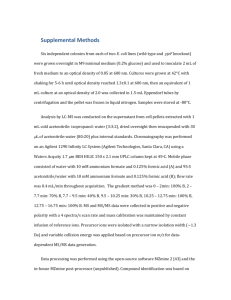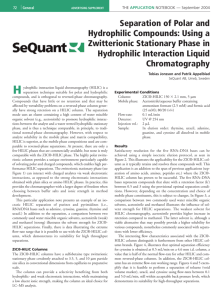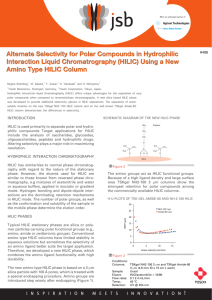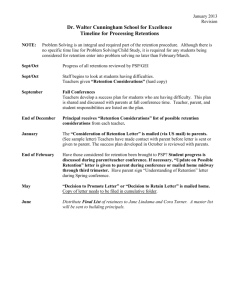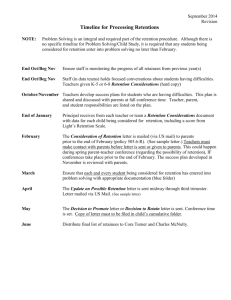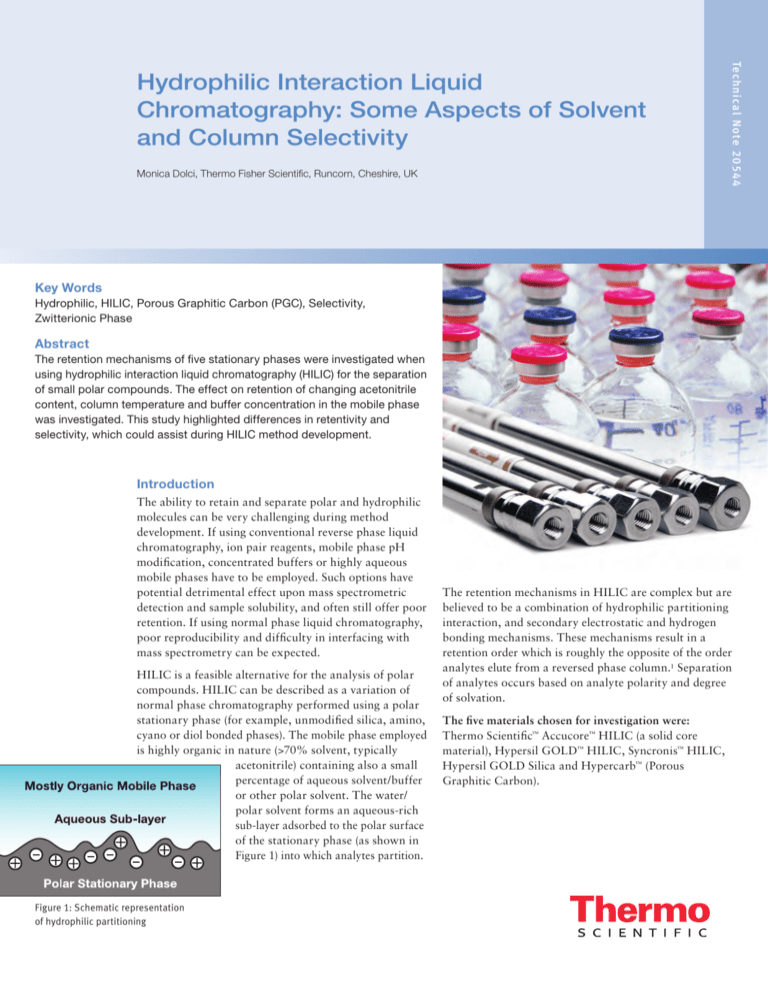
Monica Dolci, Thermo Fisher Scientific, Runcorn, Cheshire, UK
Te ch ni cal N ote 2 0 5 4 4
Hydrophilic Interaction Liquid
Chromatography: Some Aspects of Solvent
and Column Selectivity
Key Words
Hydrophilic, HILIC, Porous Graphitic Carbon (PGC), Selectivity,
Zwitterionic Phase
Abstract
The retention mechanisms of five stationary phases were investigated when
using hydrophilic interaction liquid chromatography (HILIC) for the separation
of small polar compounds. The effect on retention of changing acetonitrile
content, column temperature and buffer concentration in the mobile phase
was investigated. This study highlighted differences in retentivity and
selectivity, which could assist during HILIC method development.
Introduction
The ability to retain and separate polar and hydrophilic
molecules can be very challenging during method
development. If using conventional reverse phase liquid
chromatography, ion pair reagents, mobile phase pH
modification, concentrated buffers or highly aqueous
mobile phases have to be employed. Such options have
potential detrimental effect upon mass spectrometric
detection and sample solubility, and often still offer poor
retention. If using normal phase liquid chromatography,
poor reproducibility and difficulty in interfacing with
mass spectrometry can be expected.
HILIC is a feasible alternative for the analysis of polar
compounds. HILIC can be described as a variation of
normal phase chromatography performed using a polar
stationary phase (for example, unmodified silica, amino,
cyano or diol bonded phases). The mobile phase employed
is highly organic in nature (>70% solvent, typically
acetonitrile) containing also a small
percentage of aqueous solvent/buffer
or other polar solvent. The water/
polar solvent forms an aqueous-rich
sub-layer adsorbed to the polar surface
of the stationary phase (as shown in
Figure 1) into which analytes partition.
Figure 1: Schematic representation
of hydrophilic partitioning
The retention mechanisms in HILIC are complex but are
believed to be a combination of hydrophilic partitioning
interaction, and secondary electrostatic and hydrogen
bonding mechanisms. These mechanisms result in a
retention order which is roughly the opposite of the order
analytes elute from a reversed phase column.1 Separation
of analytes occurs based on analyte polarity and degree
of solvation.
The five materials chosen for investigation were:
Thermo Scientific™ Accucore™ HILIC (a solid core
material), Hypersil GOLD™ HILIC, Syncronis™ HILIC,
Hypersil GOLD Silica and Hypercarb™ (Porous
Graphitic Carbon).
2
Syncronis HILIC is a zwitterionic phase able to provide
weak electrostatic interactions, whose charge density is
pH-independent. The electrostatic forces of each charge
are weak because they are counterbalanced by the
proximity of an ion of opposite charge.
Porous Graphitic Carbon (PGC) provides unique separation
mechanisms, based on a combination of dispersive
interactions between the analyte-mobile phase and
analyte-graphitic surface together with charge induced
interactions of polar analytes with the polarizable surface
of the graphite (as schematically shown in Figure 3).
As a consequence of these combined interactions, PGC
material can retain polar analytes, both in typical
reversed-phase and HILIC type mobile phase conditions.
As illustrated in Figure 4, at acetonitrile concentrations
between 90–60%, analyte retention increases as
percentage of acetonitrile increases (HILIC retention
behavior); between 10–60% acetonitrile, analyte
retention decreases as the concentration of acetonitrile
becomes greater (a reversed phase retention behavior).
Figure 3: Schematic representation of charge induced interaction on the PGC surface
2.5
Cytosine
Uracil
2.0
k'
Figure 2: Functional
group of Hypersil
GOLD HILIC
Accucore HILIC and Hypersil GOLD Silica are
unmodified silica materials; Hypersil GOLD HILIC is a
weak anion exchanger, based on a polymeric amine ligand:
polyethyleneimine (Figure 2). The main benefit of using
a charged stationary phase lies in the extra selectivity
brought about by the possible electrostatic interactions
with the analyte. The strength of these interactions
depends on the ionization of the solute and the stationary
phase. The charge density is therefore pH-dependent and
high buffer concentrations may be necessary in order to
disrupt these interactions and allow the analyte to elute.
1.5
1.0
0.5
0.0
0
10
20
30
40
50
60
70
80
90
100
% Acetonitrile in the Mobile Phase
Figure 4: Analyte retention factor, k′ as a function of acetonitrile percentage in mobile phase
PGC column: 3 µm, 100 × 2.1 mm
Mobile phase: acetonitrile/water, containing 10 mM ammonium acetate, pH 4.7
Flow rate: 0.2 mL/min
Column temperature: 40 °C
Detection: ESI/MS
3
The objectives of this study were:
• I nvestigate the factors that influence retention in HILIC
mode for five stationary phases
• Gain an understanding of the chromatographic
processes that rule HILIC
• Provide a tool to facilitate method development and
method optimization in HILIC and ultimately HILIC
column selection
Experimental
Instrumentation: HPLC system equipped with a quaternary pump, a DAD detector, a degasser, a column
heater and an autosampler
Columns:
As given in Table 1
Basic test mixture:
1. uracil, 2. adenosine, 3. uridine, 4. cytosine, 5. cytidine
Acid test mixture: 1. salicylamide, 2. salicylic acid, 3. aspirin, 4. 3,4-dyhydroxyphenylacetic acid (dhpa)
Mobile phases: Various mobile phases were prepared by mixing the desired volumes of acetonitrile and stock
buffer solutions. The pH of the salt solutions was not adjusted before mixing with acetonitrile.
The salt concentrations reported in the individual results sections refer to the final
concentrations of the salt on the column
Instrumentation set-up: Flow rate:1.0 mL/min
UV:228 nm for the acid mixture and 248 nm for the basic mixture
Injection volume: Column temperature: 30 °C
5 μL
Column Name
Column
Surface Area
Dimension (mm)
(m2/g)
Pore
Size (Å)
Syncronis HILIC (5 μm)
100 × 4.6
320
100
Hypersil GOLD HILIC (5 μm)
100 × 4.6
220
175
Hypersil GOLD Silica (5 μm)
100 × 4.6
220
175
Accucore HILIC (2.6 μm)
100 × 4.6
130
80
Hypercarb (5 μm)
100 × 4.6
120
250
Table 1: HILIC stationary phases
4
Results and Discussion
Column Selectivity
Separation of the two test mixtures was carried out on
the five stationary phases, selected because they have very
different surface chemistries. The resulting chromatograms
are compared and reported in Figure 5.
Figure 5 shows that the elution orders for both acid and
basic compounds are different for the five different
stationary phases, with exception for the elution of polar
basic compounds on Hypersil GOLD HILIC and Syncronis
HILIC (Figure 5a). The five materials demonstrate
different selectivity. The higher retentivity displayed by
Syncronis HILIC is likely to be due to the higher surface
(a) Basic Test Mixture
area of this material. There is a clear lack of retention
|on Hypercarb, demonstrating the different selectivity
offered by Hypercarb under the HILIC mobile phase
conditions (as illustrated in Figure 4). Salicylic acid
(peak 2 on Figure 5b) is more strongly retained on the
Hypersil GOLD HILIC column than on any other
column, and ion exchange is likely to be responsible for
this behavior. The resolution of aspirin is much improved
on Syncronis HILIC (peak 3 on Figure 5b); this could be
the result of electrostatic interactions between aspirin
and the negatively charged groups of the stationary phase.
(b) Acid Test Mixture
Figure 5: Column selectivity for bases and acids
Mobile phase: acetonitrile/water (85/15, v/v), containing 10 mM ammonium acetate
5
The Effect of Acetonitrile Content on Retention
In HILIC, the level of organic solvent in the mobile
phase has a large influence on retention. Separation of the
two test mixtures was carried out on the five stationary
phases. The percentage of acetonitrile in the mobile phase
was varied whilst keeping ammonium acetate concentration
constant at 10 mM. The logarithmic retention factors
(ln k′) for two model compounds (salicylic acid and
cytosine) were plotted against the acetonitrile content
(Figure 6a and 6b respectively).
Salicylic acid shows typical HILIC behavior of decreasing
retention with decreasing acetonitrile content on Syncronis
HILIC and on Hypersil GOLD Silica. On Hypercarb its
retention levels off when the acetonitrile content is 80%
and below. On Hypersil GOLD HILIC and on Accucore
HILIC the retention of salicylic acid decreases initially
as the acetonitrile content decreases, but as this reaches
80% the retention gradually increases. This behavior is
likely to be due to ion-exchange interactions. Ion-exchange
interactions between salicylic acid and the amine ligand
of Hypersil GOLD HILIC would also explain the higher
retentivity observed for this analyte.
Cytosine shows HILIC behavior of decreasing retention
with decreasing acetonitrile content on the five stationary
phases. This is also true for the other components of the
basic test mixture (data not shown). This behavior indicates
that partitioning is the main retention mechanism in these
separations, regardless of the radically different chemistries.
(a)
(b)
Figure 6: Effect of acetonitrile content on the retention of salicylic acid (a) and cytosine (b)
6
The Effect of Column Temperature on Retention
(a)
Column temperature is an important parameter that can
affect retention of polar analytes in HILIC. In reversephase LC, the relationship between column temperature
and retention factor is often described by the van’t Hoff
equation:
ln k′ = - ∆H°/RT + ∆S°/R + ln j
Where:
∆ H°– retention enthalpy
∆S° – retention entropy
R – gas constant
T – column temperature
j – phase ratio
The van’t Hoff equation should also apply to HILIC; if
retention is through partitioning between the mobile phase
and the immobilized layer of water on the stationary phase,
then the relationship between ln k′ and 1/T is linear.
(b)
Figure 7: Effect of column temperature on retention of salicylic acid (a) and
cytosine (b)
Mobile phase: acetonitrile/water (90/10, v/v), containing 10 mM ammonium acetate
In this study the temperature effect on the retention of
salicylic acid and cytosine was investigated for the five
stationary phases; the column temperature was varied from
20 to 70 °C. The logarithmic retention factors for the
two model compounds were used to generate van’t Hoff
diagrams. Figure 7a shows van’t Hoff plots for salicylic
acid and Figure 7b for cytosine, on the five columns.
From Figure 7a it can be seen that a decrease in retention
is observed as the column temperature is increased on
Accucore HILIC, Hypersil GOLD Silica and to a less
extent on Syncronis HILIC. The retention increases with
the temperature on both Hypersil GOLD HILIC and
Hypercarb. Negative retention enthalpy values were
obtained for Syncronis HILIC, Hypersil GOLD Silica and
Accucore HILIC, indicating an exothermic process of
transferring salicylic acid from the mobile phase to the
stationary phase. Positive retention enthalpy values were
derived for Hypercarb and Hypersil GOLD HILIC,
suggesting an endothermic process of transferring salicylic
acid from the mobile phase to the stationary phase. For
Hypersil GOLD HILIC, the positive enthalpy of salicylic
acid could also be the evidence of both ion exchange and
partitioning processes taking place. The large enthalpy
variation of salicylic acid on this material could indicate
the change in the degree of relative contribution to the
overall retention from the two types of interaction.
Figure 7b shows a decrease in retention on the five
stationary phases as the column temperature is increased.
Linear van’t Hoff plots resulted from this study. Negative
retention enthalpy values were obtained, indicating an
exothermic process. The enthalpy values derived were
very different, which could indicate the existence of
strong specific (secondary) interactions between cytosine
and the functional groups of the five stationary phases. 2
7
The Effect of Buffer Concentration on Retention
In this study the effect of salt concentration on the
retention was investigated. Separation of the two test
mixtures was carried out on Hypercarb, Syncronis HILIC
and Hypersil GOLD HILIC. The content of acetonitrile
in the mobile phase was kept constant, whilst varying
the ammonium acetate concentration from 2.5 to 20 mM.
The capacity factors for the two model compound
mixtures were plotted against the buffer molar concentrations for the three columns. Figure 8a and 8b show the
data relative to the basic and acid test mixtures respectively obtained on Syncronis HILIC. The five bases are
fully resolved on Syncronis HILIC when low levels of
ammonium acetate are used (2.5, 5 and 10 mM). Further
increase in the salt content leads to an increase in retention,
with co-elution of adenosine and uridine. This retention
increase could be related to a partitioning process. Apart
from uracil, the other 4 bases show an increase in retention
as the ammonium acetate concentration is increased
above 5 mM, the increase being more pronounced for
cytidine. Interestingly, the retention decreases when the
buffer concentration is increased from 2.5 to 5 mM.
The general trend of increased retention as the buffer
concentration increases has been related to a hydrophilic
partitioning process. 2 The partitioning model for
HILIC assumes the presence of a water-rich liquid layer
on the stationary phase. High levels of organic in the
mobile phase could make the salt prefer to be in the
water-rich liquid layer. This would result in increased
volume or hydrophilicity of the liquid layer, thus leading
to stronger retentions.
The four acids are not fully resolved on Syncronis HILIC,
as shown in Figure 8b, with salicylic acid coeluting with
salicylamide when low levels of ammonium acetate are
used (2.5, 5 and 10 mM). Further increase in the salt
content to 15 mM leads to an increase in retention for
salicylic acid and salicylamide. It is possible that
electrostatic repulsions from the negatively charged
sulfonate groups prevented the acid molecules from
reaching the quaternary amine groups (located closer to the
silica surface), resulting in lower retentions. Higher salt
concentration could have weakened these repulsions,
leading to salicylic acid and salicylamide being more
retained. Aspirin elutes as a split peak and dhpa is very
broad when the salt content was increased to 15 mM
and above.
(a) Basic Mixture
(b) Acidic Mixture
Figure 8: Effect of buffer concentration on retention of basic and acidic
mixtures, for Syncronis HILIC
Mobile phase: acetonitrile/water (90/10, v/v)
8
Figure 9a and 9b show the data relative to the basic and
acid test mixtures respectively, obtained on Hypersil
GOLD HILIC.
(a) Basic Mixture
Figure 10a and 10b show the data relative to the basic and
acid test mixtures respectively, obtained on Hypercarb.
On Hypercarb, under the HILIC conditions relative to
this study uracil and uridine are not retained. Again, we
must refer back to Figure 4 to remind ourselves of the dual
behavior exhibited by Hypercarb and its capabilities to
retain uracil.
The other three bases are resolved, but their retention is
mostly unaffected by the variation of the buffer concentration. The components of the acidic mixture are not
resolved on Hypercarb, apart from salicylamide; their
retentions are not affected by the variation of the buffer
concentration.
(b) Acidic Mixture
Figure 9: Effect of buffer concentration on retention of basic and acidic
mixtures, for Hypersil GOLD HILIC
Mobile phase: acetonitrile/water (90/10, v/v)
To elucidate the different behaviors exhibited by the
three columns, a comparison, in terms of salicylic acid
retention, is given in Figure 11. On Hypersil GOLD
HILIC salicylic acid exhibits an opposite behavior to
what observed on Syncronis HILIC, with a dramatic
decrease in retention, as the buffer concentration
increases. The ion exchange interaction on this phase
could have a major effect on the retention of acids.
Salicylic acid is charged (mobile phase buffer pH= 6.7,
pK a for salicylic acid = 2.9) and its retention drops as the
buffer concentration increases, which is typical of an ion
exchange mechanism. The electrostatic effect was not
applicable for the bases since they are not charged in the
mobile phase. The retention of salicylic acid on Hypercarb
is not affected by variations of the salt concentration.
Te ch ni cal N ote 2 0 5 4 4
(a) Basic Mixture
Figure 11: Effect of buffer concentration on retention of salicylic acid
Mobile phase: acetonitrile/water (90/10, v/v)
(b) Acidic Mixture
Conclusion
This study has demonstrated different selectivity when
using the same mobile phase on five stationary phases,
thus proving that partitioning is not the only separation
process involved. 3 Secondary interactions such as ion
exchange (for Hypersil GOLD HILIC) and electrostatic
interaction (for Hypercarb) could explain different
elution patterns when analyzing acid compounds. This
interpretation is consistent with the thermodynamic data,
where the high differences in the enthalpy values would
indicate the existence of strong specific interactions
between the analytes and the functional groups of the
five stationary phases.
Figure 10: Effect of buffer concentration on retention of basic and
acidic mixtures, for Hypercarb
Mobile phase: acetonitrile/water (90/10, v/v)
Salt content proved to be fundamental for the full resolu­­tion
of both acids and bases. Its effect was particularly
significant on Syncronis HILIC; the general increase in
retention as the salt concentration was increased provided
indirect evidence for the hydrophilic partitioning model.
References
1. A.J. Alpert, J. Chromatogr., 499 (1990) 17
2. Y. Guo and S. Gaiki, J. Chromatogr. A, 1074 (2005) 71
3. P. Hemstrom and K. Irgum, J. Sep. Sci., 29 (2006) 1784
For more information, visit the Chromatography Resource Center at www.thermoscientific.com/crc
©2013 Thermo Fisher Scientific Inc. All rights reserved. All trademarks are the property of Thermo Fisher Scientific Inc. and its subsidiaries. This information
is presented as an example of the capabilities of Thermo Fisher Scientific Inc. products. It is not intended to encourage use of these products in any manners
that might infringe the intellectual property rights of others. Specifications, terms and pricing are subject to change. Not all products are available in all countries.
Please consult your local sales representative for details.
USA and Canada +1 800 332 3331
India 1 800 22 8374 (toll-free)
Australia 1300 735 292 (free call domestic)
+91 22 6716 2200
China +86-21-68654588
Japan +81 3 5826 1615
United Kingdom +44 (0) 1928 534 110
+86-10-84193588
France +33 (0)1 60 92 48 34
New Zealand 0800 933 966 (free call domestic)
Germany +49 (0) 2423 9431 20
All Other Enquiries +44 (0) 1928 534 050
+49 (0) 2423 9431 21
Technical Support
North America +1 800 332 3331
Outside North America +44 (0) 1928 534 440
TN20544_E 01/13M

